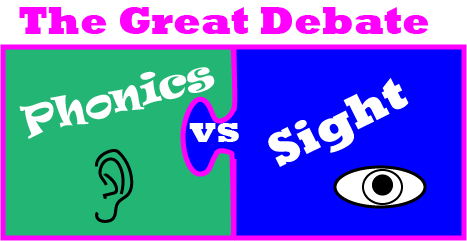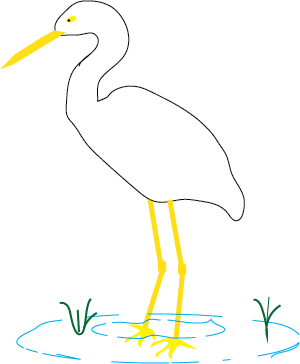Phonics vs Sight Words
Once upon a time there was a great controversy regarding phonics vs sight words. Well, yes, the controversy still rages in some quarters with advocates on both sides of the debate. And in fact, there are advantages to both.

Advantages of Phonics Instruction
- Many words can be taught at one time in a phonic family. (Examples: rat, cat, sat OR cream, dream, steam)
- It teaches students a strategy to sound out unfamiliar words.
- It helps with spelling.
- It avoids "guessing" at a word.
- It makes sense.
Advantages of Sight Words
- Many common words have irregular spellings. (Examples: is, have, was, come)
- Some pure phonics problems have simple words with unfamiliar meanings to five or six year olds. (Example: "Tom the cop did sob on the cot>" Yes those are all phonically easy words; but their meaning might be unfamiliar to young children.)
- Sight words allow a student to read "real" books and sentences with common but irregular words.
- Sight words are particularly helpful for students with certain learning difficulties, such as auditory problems.
While the controversy will likely continue to rage for years to come, today's parents can help their child read with one simple strategy: include both!
The easiest way to teach reading is to start with phonics and add sight words as needed. If your child struggles with that approach, there are more advanced methods to help both of you.
More Info on the Phonic and Sight Word Debate
Some reading experts advocate a phonics approach to reading; while others advocate for sight word instruction using whole language or other methods.- Both sides have neurological and educational psychology theories behind their preferred strategies.
- Both sides quote research to back their claims.
- There are classroom teachers and one-on-one tutors who testify to the superiority of one method or the other.
- Either side can document cases of children who failed to read with the other method but improved with their method of choice.
- Many accuse the other side of twisted reasoning or misplaced loyalties.
So, how does the parent sitting at the kitchen table or snuggled on the couch have confidence to teach reading if the experts don't agree?
Simple. Do what has always worked. Let's just break the process down a bit.
Which strategy (phonics or sight) does a competent reader use?
Both.
Try reading this word: "stringle."
How about this: "flodify."
Could you read it? You used phonics if you did.
You didn't recognize those words? Great, because they don't exist.
But if you were to read those words over and over again, your neurological system would recognize them as sight words. Here's a simple analogy. Imagine you have a file cabinet with three drawers marked "A-G" on top; "H-R" in the middle; and "S-Z" on the bottom. If you have a "p" file to put away, you might have to stop and figure out which drawer it belongs in. After repeated use, you "know" that file goes in the middle drawer without having to figure it out.
In the same way, the proficient reader has phonic strategies to decode and encode words, but also reading experience to recognize a vast number of words by sight.
- Figure it out = phonics
- Know it from experience = sight
It should be noted that this is a simplification of reality; in that theorists and teachers have been using a spectrum of methods over the last decades. Nonetheless, it is possible to see the proverbial pendulum swing from "comprehension" to "fact recognition" and back again. And it can be noted that while the overall trend swings in one direction for reading, it may be swinging in the opposite direction for math or other academic subjects.
A Delightfully Simple Model of a Complex Process
>For those of you interested in getting your PhD in this subject, the explanation here may seem a bit overly simplistic. Nonetheless, it works.Let's break reading into three steps.
#1 Pre-reading
- Enjoying books and songs
- Recognizing letters and colors
- Predicting patterns
- Discriminating sounds
- Developing a left to right orientation
- Recognizing the variety of reading activities in everyday life (books, signs, computer skills, cooking, etc.)
#2 Decoding
- Recognize word and letter patterns (phonics)
- Build an increasing vocabulary of words(phonics & sight words combined)
- Spelling (encoding)
- Increasing the fluency of oral and silent reading
#3 Reading Competency
- Reading comprehension
- Predicting
- Summarizing
- Reading from an increasing variety of written sources to acheive personal goals
A Simple Strategy
Phonics vs Sight Words: A strategy that works
The strategy we suggest seems a common sense one (but then I suppose everyone thinks their strategy rates highest for common sense.)1. Use phonics to teach word families. Groups of words can be learned together which increases the rate in which students learn new words. The student also learns important decoding skills.
2. Teach sight words needed to read common but phonically irregular or difficult words.
This strategy will work for most children. Is it guaranteed to work for your child?
Unfortunately, no.
Some children do struggle to read due to a variety of possible learning problems. Depending on the problem, some methods will work better than others.
Balanced Literacy
Read the critique about this educational method.


About Our Site
Hands-On Learning












